It is only recently that scientists have been able to observe tiny viruses and their behavior. Bacteria are a thousand times larger than viruses, and our human cells are a thousand times larger than bacteria. We still don’t know what viruses are and how they can have such a complex lifestyle while consisting of just a piece of RNA or DNA and a handful of proteins. With everyone focused on SARS-CoV-2 virus, it is important to realize that much is being learned about how viruses can communicate as cells do.
times larger than viruses, and our human cells are a thousand times larger than bacteria. We still don’t know what viruses are and how they can have such a complex lifestyle while consisting of just a piece of RNA or DNA and a handful of proteins. With everyone focused on SARS-CoV-2 virus, it is important to realize that much is being learned about how viruses can communicate as cells do.
This post will discuss recently discovered virus signals enabling communications among a community of viruses and with bacterial cells. Future posts will describe how viruses can be more helpful than harmful to humans, despite new emerging dangerous viruses. Another post will question whether there is a new way of looking at virus lifestyles that would encorporate them in the tree of life with cells.
Bacteria signals were discovered decades ago. This discovery showed that bacteria conversed as a group to make decisions about where they should seek food and whether they should attack others. Only recently has the full extent of communication among bacteria been discovered. The Secret Language of Cells, to be published soon, shows how bacteria can be so influential in human life because they speak the same language as human cells. Bacteria are able to intercept, manipulate, human cellular conversations and therefore influence many aspects of health and behavior. This has 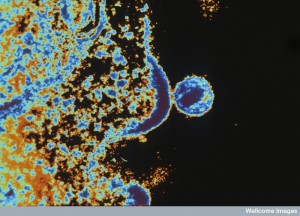 been described in multiple previous posts, and is summarized, synthesized, and organized in the book.
been described in multiple previous posts, and is summarized, synthesized, and organized in the book.
For years, this blog showed how viruses have complex lifestyles. (See posts on Ebola, HIV, Dengue, Varicella). The implication of such complex abilities to control much larger human cells, and evade the complex immune attacks, had to be that they also were communicating with each other as bacteria and other cells do.
The First Virus Signal
But, being so small, the first actual signal was discovered in 2017 for a type of virus called bacteriophage—or phage for short—that is, a virus that uses bacteria as their host for reproduction. Phage viruses travel with their bacteria, sometimes help them fight against enemy bacteria by providing genetic code to produce toxins against enemies. Sometimes the phage destroys their host cell after it has used the bacterium to reproduce thousands of new viruses. Sometimes, phage live for long periods peacefully inside the bacterium and are passed on to the children of the bacterium.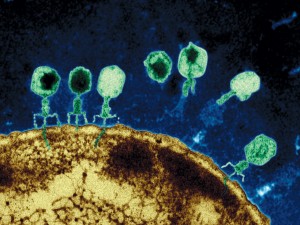
In the past three years, the floodgates have opened in this research and now many signals have been found for a large number of different viruses, placing viruses clearly as part of the cellular conversations described in the book.
This first signal was named “arbitrium”—from the Latin word for arbitration—because they were arbitrating a decision about whether to kill their host bacterium or not. This first virus signal is a small peptide produced from the virus RNA. Now, fifteen different phage viruses have been found to have various signals and an entire new field has been started called sociovirology. Viruses that use human cells as hosts also have been found to have signals—including the viruses for polio, hepatitis, measles, and flu.
A very surprising finding is that different species of viruses can understand the same signals. This is in line with the fact already mentioned that by understanding the same languages as human cells, bacteria, and now viruses can have dramatic impact on human cell functioning. Understanding signals from human cells allows these microbes to intercept them and manipulate human cells. Previous posts and the new book describe the many ways that viruses manipulate, evade, and control processes in human cells—all by speaking the same language!
 One finding from this research is that virus communities make decisions as to whether they will cooperate or go it alone. Phage viruses have very complex relationships with their bacteria and very elaborate ways of transferring information. Viruses can live inside the bacteria and then sometimes produce proteins that bacteria use, for example, they can produce well known toxins used by bacteria. In fact, many of the most well-known toxins from bacteria are produced by their fellow phage viruses. These include Cholera toxin, Diptheria toxin, Strep throat super antigen, Enterotoxin P with gastroenteritis, and Shiga toxin for Dysentery.
One finding from this research is that virus communities make decisions as to whether they will cooperate or go it alone. Phage viruses have very complex relationships with their bacteria and very elaborate ways of transferring information. Viruses can live inside the bacteria and then sometimes produce proteins that bacteria use, for example, they can produce well known toxins used by bacteria. In fact, many of the most well-known toxins from bacteria are produced by their fellow phage viruses. These include Cholera toxin, Diptheria toxin, Strep throat super antigen, Enterotoxin P with gastroenteritis, and Shiga toxin for Dysentery.
Viruses can transfer information among a community of bacteria such as giving them genes that will fight against antibiotic medications, making them resistant to treatment. Sometimes the viruses give multiple genes that will block the actions of a variety of antibiotics, some that haven’t even been used yet against the bacteria, but might be used in the future. And also, bacteria can produce their own viruses as messages to other bacteria in the community.
The first phage arbitrium signal has six amino acids and is produced by a virus entering a bacterium. It is used to tell others that this virus has entered the host, much as bacteria use quorum sensing to signal a gathering group of bacteria. It signals to other phages that a host has been infected. Other viruses in the community also produce this signal and when a large number of these signal molecules accumulate, the community slows their activity so as not to kill their host, which is providing the reproduction machinery. Viruses somehow have receptors for these signals that are just being discovered.
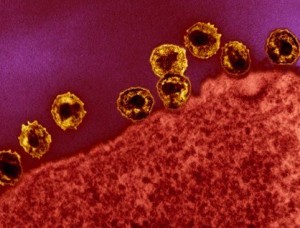 While some of the signals produced are understood by multiple different species of phage viruses, more than a dozen types of phage viruses have been found that only are used by their community and these signals can alter the behavior of their bacterial host. It appears that virus signals can alter the DNA of bacteria to alter functions, but more research has to be done on this. From these signals, the virus community decides when to attack the host and when to continue reproducing. Signals can also stimulate the bacterium to hibernate.
While some of the signals produced are understood by multiple different species of phage viruses, more than a dozen types of phage viruses have been found that only are used by their community and these signals can alter the behavior of their bacterial host. It appears that virus signals can alter the DNA of bacteria to alter functions, but more research has to be done on this. From these signals, the virus community decides when to attack the host and when to continue reproducing. Signals can also stimulate the bacterium to hibernate.
Because of their great influence on bacteria, increasingly phage viruses are being used to fight difficult to treat bacterial infections. The use of phage viruses to treat infections was actually first discovered just over a century ago ten years before the discovery of penicillin. Once penicillin was found, it was so effective that there was no interest in pursuing phage as treatment for almost a century. Now with terrible resistant strains of bacteria that are not responding to multiple antibiotics, there is renewed interest in using phage viruses again for treatment. Phage may be the future treatment of choice for multi resistant bacteria.
Bacteria Defense Systems and Virus Responses
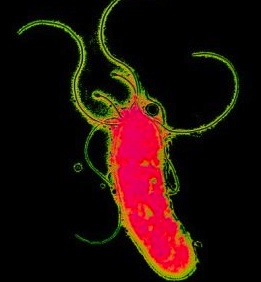 From the research about how bacteria defend themselves against viruses, it was noted that there are a wide variety of systems used by bacteria to identify and kill enemy viruses. One of these bacterial immune system has become famous as an adapted tool to edit DNA and RNA by scientists for all type of purposes. While complex, CRISPR-Cas9, is really just a way for a bacterium to take a piece of an invading virus, cut a piece of it, and store it in the bacterial genetic material. It is filed away until another virus enters the cell and the stored virus piece is used to identify this invading virus and kill it. Cas is the enzyme the system uses to cut the virus. There are in fact dozens of different systems of this type that have recently been discovered, including many different car enzymes.
From the research about how bacteria defend themselves against viruses, it was noted that there are a wide variety of systems used by bacteria to identify and kill enemy viruses. One of these bacterial immune system has become famous as an adapted tool to edit DNA and RNA by scientists for all type of purposes. While complex, CRISPR-Cas9, is really just a way for a bacterium to take a piece of an invading virus, cut a piece of it, and store it in the bacterial genetic material. It is filed away until another virus enters the cell and the stored virus piece is used to identify this invading virus and kill it. Cas is the enzyme the system uses to cut the virus. There are in fact dozens of different systems of this type that have recently been discovered, including many different car enzymes.
By looking into virus signals it has been found that viruses can fight back against the CRISPR-Cas bacterial defense systems. The community of viruses send viruses to attack, like kamikaze pilots in World War II. These first viruses are killed, but this produces a molecule that the viruses can use to attack the CRISPR system itself. Researchers are now in the process of deciphering a complex communication system in which viruses work together against the central bacterial CRISPR defense system.
A form of altruism appears to occur in the viral community related to CRISPR. Several viruses must first attack the CRISPR bacteria defense system and these are killed in the process. This attack, however, produces a molecule that is then used by other members of the viral community against the bacterial CRISPR system. One group of viruses, therefore, depends on another group to die for overall viral survival.
Other viruses have recently been found to cooperate in different ways. For example, polioviruses 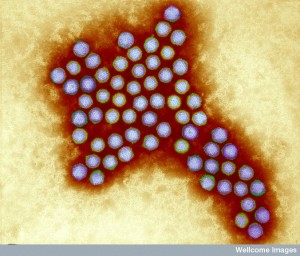 collaborate by sticking together, which produces a more effective raid against host animal cells. Another example occurs in an infection caused by a virus in a mouse, where the viral members share molecules in sacs sent between cells while evading immune cells. In these sacs, the virus is more effective in causing infection. In fact, many different viruses use sacs to travel while inside the human body. These viruses include zika, hepatitis, norovirus, and the varicella-zoster virus (the virus that causes chicken pox).
collaborate by sticking together, which produces a more effective raid against host animal cells. Another example occurs in an infection caused by a virus in a mouse, where the viral members share molecules in sacs sent between cells while evading immune cells. In these sacs, the virus is more effective in causing infection. In fact, many different viruses use sacs to travel while inside the human body. These viruses include zika, hepatitis, norovirus, and the varicella-zoster virus (the virus that causes chicken pox).
When scientists are able to better understand these virus signals, treatments could be developed to use viruses in different ways to kill infectious bacteria. Some strategies might include using multiple cooperating viruses to protect human cells and helpful bacteria while eliminating dangerous bacteria and perhaps even cancers. Finding the signals to start and stop hibernation will help in the treatment for many diseases.
We Live in Vast Ocean of Viruses
 We are, in fact, surrounded by an ocean of viruses—at least a hundred times more than all cells that exist on earth. The number of phage viruses is 10 to the 31st, that is 10 with 31 zeroes–a number larger the number of stars that we know. Future posts will discuss how this vast ocean of genes has overall actually been more helpful to humans than harmful, despite the terrible toll of emerging viruses that cause human illness. We will discuss how embedded ancient strands of DNA from virus like particles make up a substantial portion of our DNA and produce many useful products that humans need, including digestive enzymes and the molecule that allows the placenta to function. We will also discuss whether viruses are “alive” and what can be done to avoid emerging dangerous viruses.
We are, in fact, surrounded by an ocean of viruses—at least a hundred times more than all cells that exist on earth. The number of phage viruses is 10 to the 31st, that is 10 with 31 zeroes–a number larger the number of stars that we know. Future posts will discuss how this vast ocean of genes has overall actually been more helpful to humans than harmful, despite the terrible toll of emerging viruses that cause human illness. We will discuss how embedded ancient strands of DNA from virus like particles make up a substantial portion of our DNA and produce many useful products that humans need, including digestive enzymes and the molecule that allows the placenta to function. We will also discuss whether viruses are “alive” and what can be done to avoid emerging dangerous viruses.
More about viruses in the new book The Secret Language of Cells to be published in September
